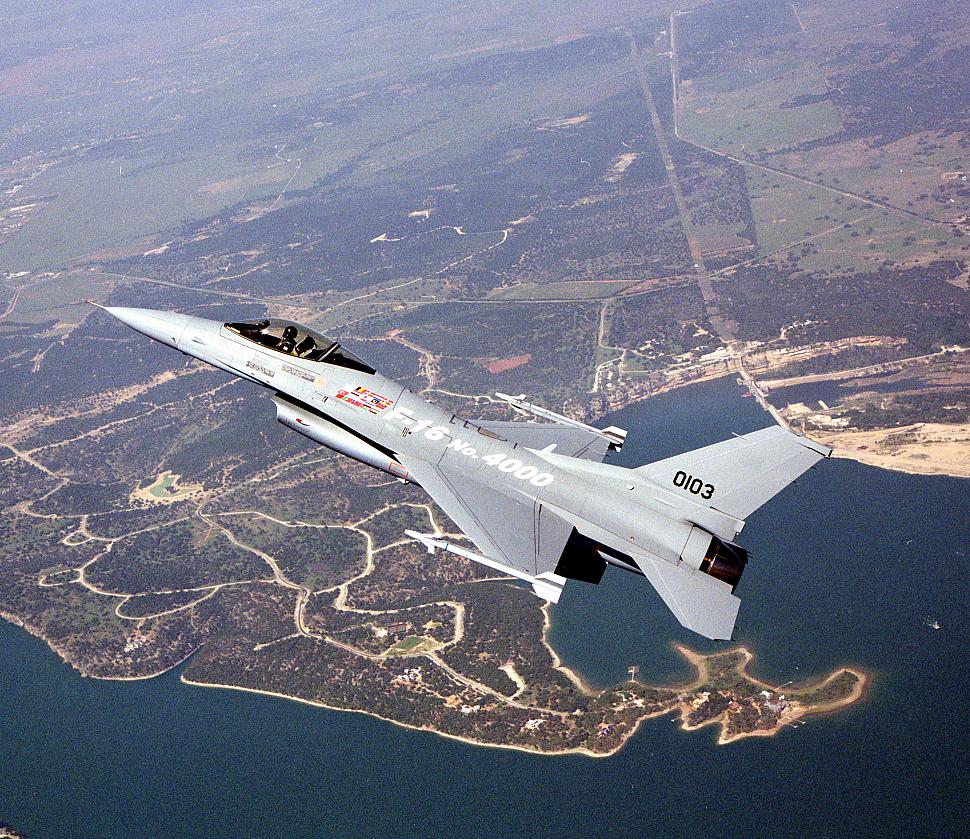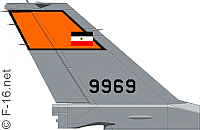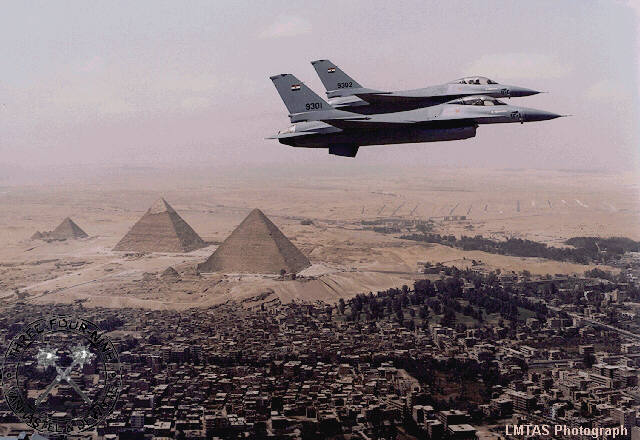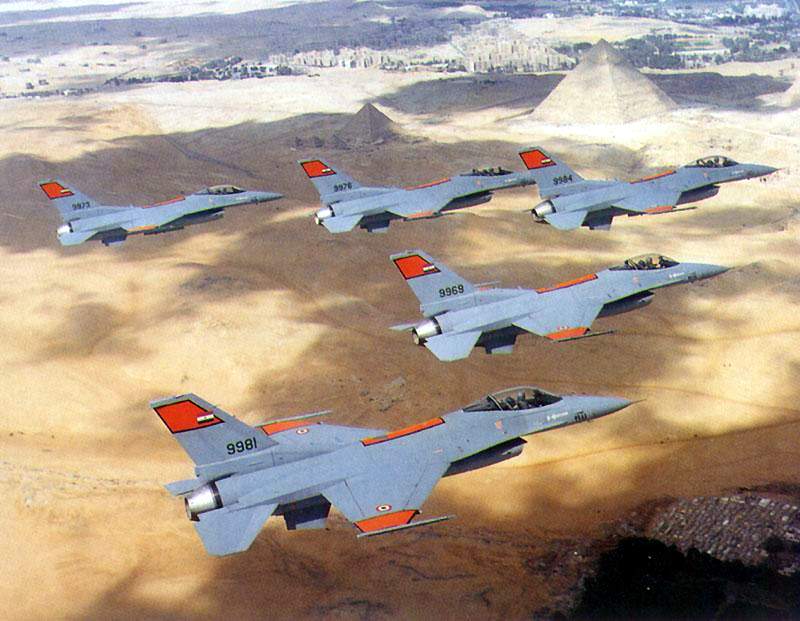Introduction
The Egyptian Air Force operates 220 F-16s, making it the 4th largest F-16 operator in the world. The F-16 is the EAF's primary frontline aircraft, and is used for both air defence and ground attack.
History
When Egypt had to rebuild their armed forces after the devastating losses suffered during the 1967 six-day war with Israel, it turned to the USSR as its main supplier for aircraft. Russian advisors and instructors played a crucial role in the rebuilding of the air force.
During the 1973 Yom Kippur war with Israel, Egypt's air force performed well but could not secure the victory. The EAF lost some 100 of its 220 aircraft during this conflict, including most of its MiG-21 and Il-28 fighters and bombers.
After the Yom Kippur war, Russia stalled deliveries of new aircraft. Because of this, Egypt turned to other suppliers, notably France and the US. In 1979 the government of Egypt signed a peace treaty with Israel, ending over 30 years of tension and hostilities. With the peace treaty signed, Egypt became a major recipient of United States military aid.
Deliveries of Western equipment started with French Mirage 5 aircraft and US F-4E's. In the early 80s, Egypt ordered Mirage 2000's and F-16A/Bs, followed by F-16C/Ds in the mid-eighties.
Recently, Egypt has also turned to China as a mainly cheaper source of fighter aircraft

Inventory
Peace Vector I
On June 25, 1980, Egypt signed a letter of agreement to acquire 42 block 15 F-16A/B fighters (34 single-seaters and 8 two-seaters) under the Peace Vector I FMS (Foreign Military Sales) program. The first F-16 was accepted by the Al Quwwat al Jawwiya Ilmisriya (Egyptian Air Force) during a ceremony at Fort Worth in January of 1982, with the first six planes arriving in Egypt on March 16th of that year. F-16B #9207 was rather exceptional, as it was built by Fokker in The Netherlands. By 1997, all Block 15 aircraft were (or were being) modified to block 42 standard (see 'Modifications'). Since Egyptian Air Force F-16s were acquired under Foreign Military Sales, they carry USAF serial numbers for administrative purpose. In service, they carry a four-digit EAF serial number on their vertical tails.
Peace Vector II
One year later, Egypt ordered 40 additional F-16C/D's (34 C's and six D's) with AIM-7 Sparrow capability. These were block 32 machines, and were some of the few examples of F-16C/D's being built that were compatible with the AIM-7 Sparrow. In October of 1986, the first F-16C arrived in Egypt under Peace Vector II. The 242nd Regiment at Beni Suef began operating F-16C/D's in October 1986. By 1997, all block 32 aircraft were modified to Block 42's (see 'Modifications').
Peace Vector III
In June of 1990, Egypt signed an order for 35 block 40 F-16C's and 12 Block 40 F-16D's, powered by the General Electric F110 turbofan. This order was under Peace Vector III, and these planes were intended to equip two squadrons as well as to make up for attrition. The first Peace Vector III F-16s were delivered to Egypt in October of 1991.
Peace Vector IV
A contract to produce 46 Block 40 F-16C/D's for the Egyptian Air Force was placed with TUSAS Aerospace Industries (TAI) of Turkey. 34 of them will be F-16C's, 12 will be F-16D's. This was carried out under the auspices of the Peace Vector IV program, and marked the first sale of a foreign-built Fighting Falcon to a third-party nation in the history of the F-16 program. The first aircraft was delivered in early 1994, and deliveries continued into 1995. All but one of the earlier F-16s for Egypt had originated on the Lockheed/General Dynamics production line at Fort Worth. For formal bureaucratic reasons dealing with the rules and regulations under which the Foreign Military Sales program operates, TAI is not allowed to deliver F-16s directly to Egypt. Instead, the aircraft are initially delivered to the USAF, which then turns them over to Egypt. Egypt had received a total of 175 Fighting Falcons by the time all the TAI machines were delivered.
Peace Vector V
In May 1996 the governments of Egypt and the United States signed an agreement providing for the sale of 21 new F-16C/D Block 40 aircraft to the Egyptian air force. The contract is worth $670 million. That is Egypt's fifth order of F-16s over the last fifteen years. The new Egyptian aircraft will be manufactured in Fort Worth. Deliveries begin in 1999. The engines will be the General Electric F110-GE100B's. Egypt will use the new production F-16s as well as the modernized F-16s to maintain a self defense capability. These new aircraft, as well as the aircraft being delivered from prior F-16 purchases, will replace aging Soviet-origin aircraft. As it might turn out, these new aircraft will be spread among the existing F-16 Block 40 units at Abu Suwayr and Genacklis.
LMTAS' Fort Worth plant began building the first of these 21 F-16s in 1999.
Peace Vector VI
In February 1999, the US Government and Egypt were close to announcing approval for sale of 24 new build F-16s for the Egyptian Air Force. Financing for the sale is in place through the US FMS program. Once the US Embassy in Egypt finishes writing the official letter of offer and acceptance, the deal can be announced to Congress. Congress is not likely to oppose the deal, since Egypt already has taken delivery of 196 of the aircraft, and 24 more will not shift the balance of power in the area.
On March 6th of that same year, the United States agreed to sell Egypt $3.2 billion worth of new American weapons, including 24 F-16 Block 40 aircraft, 200 M-1A1 tanks and 32 Patriot missiles. Egypt would pay for the arms from the $1.2 billion a year it gets in US military aid. The 24 F-16 fighters would cost $1.2 billion.
Peace Vector VII
On December 24th, 2009 the US signed a contract with Egypt for the delivery of 20 new F-16s under the known Peace Vector series. Notification to Congress already happened last October, so everything is ready to finalise this deal. With this new order the number of F-16s delivered to Egypt raises to 240. Although Egypt has a large fleet of GE powered block 40s, the new deal compromises PW powered block 52 versions. The order compromises 16 C-models and 4 D-models.
| Program | Model | Block | Qty. | Serials | Delivered |
|---|---|---|---|---|---|
| Peace Vector I | F-16A | Block 15 | 34 | 9301/9334 | 1982-1983 |
| F-16B | Block 15 | 8 | 9201/9208 | 1982-1985 | |
| Peace Vector II | F-16C | Block 32 | 34 | 9501/9534 | 1986-1988 |
| F-16D | Block 32 | 6 | 9401/9406 | 1986-1987 | |
| Peace Vector III | F-16C | Block 40 | 35 | 9901/9935 | 1991-1995 |
| F-16D | Block 40 | 12 | 9801/9812 | 1991-1993 | |
| Peace Vector IV | F-16C | Block 40 | 34 | 9951/9984 | 1994-1995 |
| F-16D | Block 40 | 12 | 9851/9862 | 1994-1995 | |
| Peace Vector V | F-16C | Block 40 | 21 | 9711/9731 | 1999-2000 |
| Peace Vector VI | F-16C | Block 40 | 12 | 9732/9743 | 2001-2002 |
| F-16D | Block 40 | 12 | 9863/9874 | 2001-2002 | |
| Peace Vector VII | F-16C | Block 52 | 16 | 9751/9766 | 2012-2013 |
| F-16D | Block 52 | 4 | 9821/9824 | 2012-2013 |
Modifications & Armament
Modifications & Armament
Together with the 5th order, Egypt decided to modify older F-16C/D aircraft in-country through Engineering Change Proposals detailing requirements for the installation and integration of HARPOON and GBU-15 weapons capability, aircraft radar modifications and other related elements of program support. Principal contractors for the upgrade program will be McDonnell Douglas, St. Louis, Mo.; Rockwell International, Tactical Systems Division, Duluth, Ga. and the Westinghouse Electronic Systems Group, Baltimore, M.D.
All aircraft in the Block 15 and 32 series have been or will be upgraded with most Block 40/42 features, thus retaining the Pratt&Whitney F-100 engines and the small inlet ducts. As a consequence, every Egyptian F-16 (Block 15, 32 or 40) can accommodate the LANTIRN-system (they have been modified with the holographic HUD) giving them full autonomous laser weapon handling (i.e. GBU-15's, AGM-65D's). Together with the 6th deal, a batch of AGM-88 missiles was also delivered for usage on the block 40 airframes.
Operational Service
Units
Please refer to the F-16 Units section for an overview of units.Special thanks
- Henrik "The Viper" Gram.
Please use this form to add any list any error or omissions you find in the above text.
Note: your comments will be displayed immediately on this page. If you wish to send a private comment to the webmasters, please use the Contact Us link.



